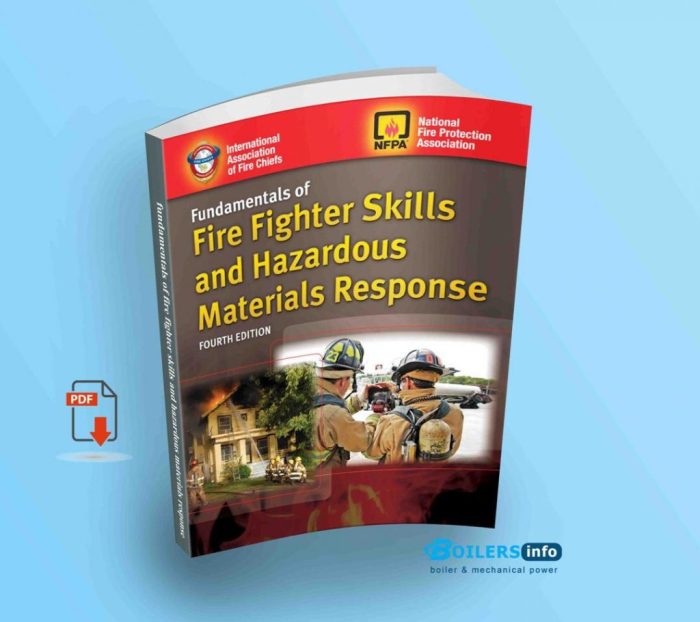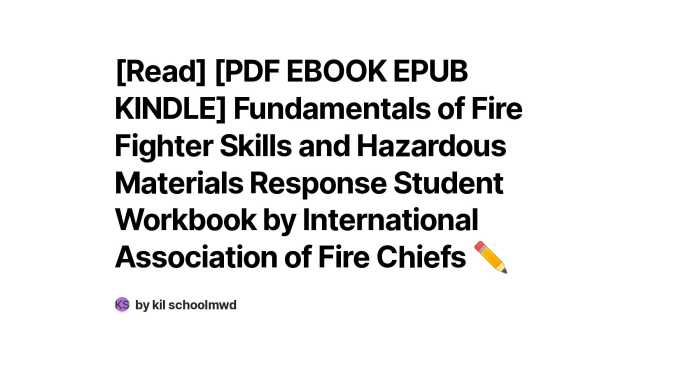Fundamentals of fire fighter skills and hazardous materials response – Fundamentals of Firefighter Skills and Hazardous Materials Response introduces readers to the critical knowledge and techniques required in firefighting and hazardous materials management. This comprehensive guide provides a thorough understanding of the essential skills, equipment, and safety protocols for firefighters, enabling them to effectively respond to and mitigate emergencies.
Delving into the complexities of hazardous materials, the guide explores their potential risks, identification protocols, and assessment strategies. It emphasizes the significance of personal protective equipment (PPE) for firefighters, detailing its types, functions, maintenance, and inspection procedures.
Core Firefighting Skills
Firefighting is a demanding and hazardous profession that requires a comprehensive set of skills and knowledge. Core firefighting skills encompass the fundamental principles of extinguishing fires, utilizing essential tools and equipment, and adhering to strict safety protocols.
Firefighters employ a range of techniques to combat fires, including water application, foam suppression, and chemical extinguishing agents. Each technique is tailored to specific fire types and materials, ensuring effective and efficient firefighting operations.
Essential Firefighting Tools and Equipment
- Fire hose and nozzles
- Ladders and aerial devices
- Breathing apparatus
- Fire extinguishers
- Thermal imaging cameras
- Ventilation equipment
Safety Protocols for Firefighters
Firefighters face numerous hazards, necessitating adherence to strict safety protocols. These protocols include:
- Wearing appropriate personal protective equipment (PPE)
- Following established fireground procedures
- Maintaining situational awareness and communication
- Understanding fire behavior and risk assessment
Hazardous Materials Response

Hazardous materials incidents pose significant risks to firefighters and the community. Firefighters must be equipped to identify, assess, and mitigate these hazards effectively.
Definition and Potential Risks of Hazardous Materials
Hazardous materials are substances that can pose a threat to human health or the environment due to their toxicity, flammability, reactivity, or corrosive properties.
Potential risks associated with hazardous materials include:
- Fire and explosion
- Chemical exposure and poisoning
- Environmental contamination
Types of Hazardous Materials and Their Properties
Hazardous materials can be classified into various categories based on their properties, including:
- Flammable liquids and gases
- Toxic substances
- Corrosive materials
- Radioactive materials
Protocols for Identifying and Assessing Hazardous Materials Incidents
Firefighters utilize a systematic approach to identify and assess hazardous materials incidents, involving:
- Scene assessment and risk evaluation
- Identification of hazardous materials using specialized equipment
- Development of appropriate response plans
Personal Protective Equipment (PPE)
PPE is essential for protecting firefighters from the hazards they encounter. It provides a barrier against heat, flames, chemicals, and other dangers.
Importance of PPE for Firefighters
PPE is crucial for firefighters’ safety, reducing the risk of injuries and fatalities during firefighting operations.
Types of PPE and Their Functions
Firefighters utilize various types of PPE, each designed for specific protection:
- Firefighting turnout gear:Protects against heat, flames, and chemicals
- Breathing apparatus:Provides clean air supply in hazardous environments
- Helmets:Protects the head from impact and debris
- Gloves:Protects hands from heat, chemicals, and sharp objects
- Boots:Protects feet from heat, chemicals, and punctures
Maintenance and Inspection Procedures for PPE
Regular maintenance and inspection of PPE are essential to ensure its effectiveness. This includes:
- Cleaning and decontamination
- Visual inspections for damage or wear
- Functional testing
Emergency Medical Services (EMS)

Firefighters often play a vital role in providing EMS to victims of accidents, injuries, or medical emergencies.
Role of Firefighters in EMS, Fundamentals of fire fighter skills and hazardous materials response
Firefighters are trained to provide basic and advanced life support, including:
- First aid
- CPR
- Defibrillation
- Trauma care
Basic Principles of First Aid and CPR
First aid and CPR are essential life-saving techniques that firefighters must master:
- First aid:Provides immediate care to injuries and medical emergencies
- CPR:Restores breathing and circulation in cardiac arrest victims
Equipment and Supplies for EMS
Firefighters carry a range of equipment and supplies for EMS, including:
- First aid kits
- Automated external defibrillators (AEDs)
- Oxygen tanks
- Trauma supplies
FAQ Corner: Fundamentals Of Fire Fighter Skills And Hazardous Materials Response
What are the essential firefighting tools and equipment?
Firefighting tools and equipment include hoses, nozzles, ladders, axes, forcible entry tools, and breathing apparatus.
How do firefighters assess hazardous materials incidents?
Firefighters assess hazardous materials incidents by identifying the material, determining its risks, and evaluating the potential for exposure.
What is the role of firefighters in providing emergency medical services?
Firefighters provide emergency medical services by administering first aid, performing CPR, and transporting patients to medical facilities.